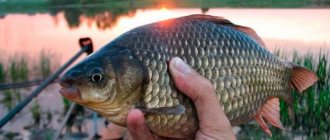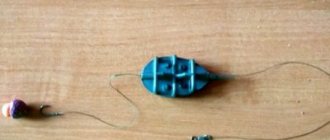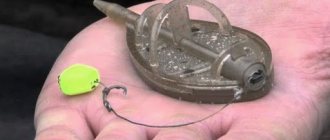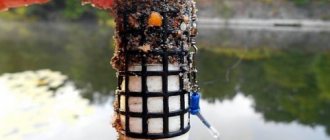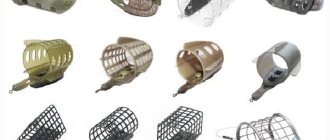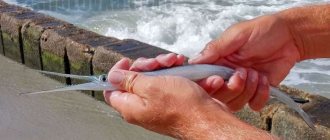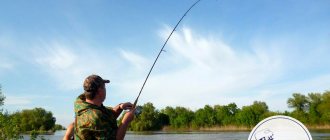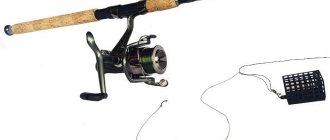Fishing on “commercial reservoirs” seems simple and easy, what’s wrong with that?! I arrived at the pond, mixed up any bait mixture bought at the first fishing store I came across and, as a rule, the cheapest, threw in my gear and sat and waited for a bite. Yes, of course, there are days when people visiting paid reservoirs “get into fish,” so to speak, and those who throw their equipment in different places wait a long time for a bite, or go home without seeing it at all. In today's article we will talk about fishing on a commercial reservoir with delicate gear called a picker.
The previous fishing session with a flat feeder brought nothing except a few crucian carp, so for this trip I took, in addition to two rods equipped with “flat” type feeders, a picker rod from the Volzhanka company in height 2.7 with a working test of 25g + in case of fishing with small fish fish waiting for bites on the flat. To be honest, I don't really like fishing on commercial waters. Firstly, not all owners constantly stock water bodies with fish, and secondly, some owners catch fish with nets for sale. Well, this is probably a “family kitchen” and it’s not for me to get into it.
Studying the bottom, measuring the depth, choosing a fishing spot
Dragging the marker weight along the bottom, except for silt and small holes and tubercles, I did not find anything that could be “considered a promising point” and in the final stage we would focus our attention and clip this distance. A smooth bay with an almost flat muddy bottom and depths of up to 1 meter maximum. Coming out of this situation, my actions were to check one section of the reservoir, where there was an island of reeds that had just begun to turn green and was located almost in the middle of the lake.
It was at the wall of the reeds that that very “promising point” was located; what’s more, there were even several of them. After all, the following picture emerges: the fishing distance is 21-23 meters with a depth of just under 1 meter to 1.2-1.3 meters, a pronounced hole with a small exit to several “tables” literally half a meter from the walls of the reeds, where I clipped this distance.
Approximate diagram of the bottom structure
What is the flat feeder method?
The flat-method is a flat feeder, the sole of which does not get stuck in the mud, and the leash and hook do not cling to the grass (they are hidden in the bait). The classic version has a flat base and a framed solid upper part (plastic or metal). A special tube passes through the body of the feeder to pass the fishing line.
Flat method feeders are more often used for catching carp in silted reservoirs or with an abundance of aquatic vegetation. As a rule, they are used on lakes with standing water or rivers with a small current.
Fishing place and pond
Due to the spring ban on fishing in my favorite water bodies, it is almost impossible to catch fish, and it is extremely risky to get a fine, I don’t know about other regions of our country, but in the Krasnodar Territory, especially the Republic of Adygea, there is some kind of “paradox” with spring fishing ": reading articles on the Internet, it seems that no more than two hooks are allowed, especially for us - fishermen who practice and promote fishing on a feeder, where only one hook is used, it is certainly possible to catch, but the fishermen who approached me while fishing were interested in today's They told me the exact opposite, that they were chasing everyone everywhere! In particular, the Kuban River, the Krasnodar reservoir and its bays, the Psekups River, canals and other reservoirs, with the exception of commercial ones. In order not to risk it, we decide to have a fishing session with a friend on one of the paid reservoirs near the city of Krasnodar, Republic of Adygea, Takhtamukai district.
Tips and baits for flat fishing
Nozzles for flat feeders can be natural or made on their basis - boilies. Natural – these are any plant and animal baits. Boilies come in floating (pop-up) and sinking types.
- Boyles;
- Corn, peas, pearl barley;
- Worm, maggot, bloodworm, etc.
You need to fish with a flat feeder based on what the fish choose today. If catching small fish is not part of your plans, to get rid of small fish, you should use large baits - boilies, corn, peas. When fishing with floating (pop-up) baits, you need to take into account the weight of the hook, and, if necessary, adjust the buoyancy using a shotgun weight on the leash.
Lure
In my fishing bag there are always a couple of packets of some kind of “universal” base mixture, in my concept a base or universal mixture, something other than a mixture of basic components that attract and work on most types of fish. Naturally, these mixtures can be used as a self-sufficient mixture, but also by combining these mixtures with more expensive baits or with baits targeted at certain types of fish, thereby increasing the volume of the mixture itself and making up the mixtures you need along with the correct “mechanics” of how your bait works mixtures. In this case, at this fishing session with an English donkey, my composition consisted of one package of 0.5 kg of the universal ready-made winter mixture Pelican + 0.5 kg of a mixture aimed at roaches + 0.5 kg of cheap bait that had been lying around for a long time, which was given out last season at the tournament, such a mix of a light, moderately dusty mixture with a hint of bait aimed at crucian carp, which should take on the function of attracting.
Characteristics of flat method feeders
The most popular are flats from Preston, Drennan, ESP, Korum and they differ in:
- form;
- weight;
- sizes;
- coloring;
- frame configurations for holding bait;
- feed containers;
- type of connectors for tying a leash;
- loading form;
- cost.
The flat method is an economical type of fishing, but the price of imported feeders is still high, so it is welcome that our manufacturers have begun to compete with foreign brands and even win this competition.
The flat must have a streamlined shape in order to “break through the wind when casting, and a special mold device or “presser” is used to press the bait.
With the help of this gadget, it is possible to give a structure filled with bait excellent flight characteristics, and this allows you to fish at ultra-long distances. But other qualities of feeders are also important, on which their choice depends.
Flat weight
Feeders offered by manufacturers have a weight range from 10 to 120 grams, covering all possible fishing conditions.
When fishing at short distances, light weight flats, up to 30 grams, are used, and at a distance of 40 meters and further, heavier feeders from 40 to 120 grams are needed.
The choice of flat weight also depends on the test of the feeder rod used for fishing and this should also be taken into account. When testing a rod weighing 90 grams, feeders weighing up to 90 grams are used along with bait.
Unfortunately, situations are possible when, during a power cast, a rod breaks, the test of which is lower than the weight of the flat with bait. But this happens if the load on the form is maximum.
When casting gently at short distances, a slight discrepancy between the rod test and the weight of the filled structure is allowed. Light flats are inconvenient to cast with rods with large dough, because they do not “load” the blank when casting and discomfort occurs.
When fishing at distant points, they use rods with a margin of strength and weight, and the heaviest flats that can overcome both wind and distance.
Size and feeding capacity
The size of the feeder for fishing using the flat method affects its flight characteristics, because a large flat is more difficult to cast over a significant distance. But a larger feeder can accommodate more bait, and a larger nozzle is used with it.
Some fishermen think that the more food the feeder can hold, the better it will be able to attract fish and “work” longer. This is a mistake, because the fish considers the feeder with the bait mixture as a food object and must suck in all the bait at once, along with the bait.
If fishing is carried out on a pre-fed spot, then there is no need for flats of large dimensions at all. But even during search fishing, all sizes work successfully.
Using the example of Preston In-Line Flat Method Feeder feeders, which are considered the best by many anglers, we will consider size options for fishing with flat method equipment.
These feeders are available in three sizes S (small), L(Large), XL(X-Large), and corresponding weights.
Flat Small, weighing up to 45 grams, is used for catching cautious and inactive fish at close range. It is convenient to cast with delicate picker rods and when splashed down, the feeder does not create any noise that can scare away the fish. Catching small carp with such flats on classic English-type reservoirs gives great pleasure to the fisherman.
XL feeders are also available in weights up to 45 grams and are used when fishing at short distances, but also on slushy mud and grass, they have advantages due to the larger area of the loaded bottom. The feeding capacity of such a flat is higher and, accordingly, the weight with bait is also higher, which allows you to make long casts, increasing the chances of catching large trophies.
The most popular Preston Large feeder is available in weights up to 80 grams, and together with bait its weight reaches 95-10 grams, which makes it possible to fish at long and super-long distances, from 80 to 140 meters and beyond.
Every fisherman needs to have a set of flat feeders that differ in weight, size and feed capacity.
Important!!! Do not try to use flats of the largest sizes; this will not have a positive effect on the fish catch.
Frame configuration and shape
The advantage of the Preston In-Line Flat Method Feeder over other models is also due to the successful configuration of the frame and ribs designed to hold the bait when casting. The ribs of the feeders are widely spaced, which allows you to comfortably use nozzles with a diameter of 10-12 mm, and they will not be crushed when the bait is pressed using a mold.
The Preston In-Line Flat Method Feeder has an oval shape, and this factor affects the distance of power casting.
The Drennan In-Line Flat Method Feeder has a teardrop shape, which also shows good flight qualities. An exact analogue of such a flat is produced domestically. But compared to the Preston, in terms of casting range, this feeder still loses, although it has its fans.
Most flat-method feeders have an in-line design; they are equipped with a tube passing through the body of the feeder along the entire length. Thanks to the tube, both sliding and blind installation of the flat feeder can be done, which allows you to diversify your fishing.
Flavors and Additives
Having a quite good, own vanilla-corn aroma with notes of aromatic biscuit, I did not add any flavorings or liquids to my mixture. One addition to the fishing process itself was two options for additives, which I added immediately before filling the feeder with bait. Dry flavoring Pelican garlic and attractive phantom tiger nut are a specific thing, a liquid flavoring that, when it gets into the water, begins to “swirl” creating an aromatically colored attractive turbidity, thereby appealing to the “scaly ones” to actively search for food.
